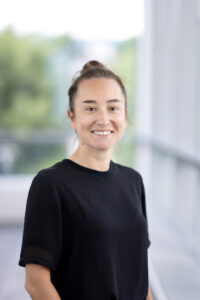
Growing up, Dr. Sarah Kraeutner liked to build things and had always wanted to be an engineer. However, after taking some psychology courses during her undergrad, she became interested in how the brain works and how it can recover after an injury, such as a stroke. She went on to complete her Master’s and PhD in Psychology and Neuroscience at Dalhousie University, taking part in the RADIANT program, which focused on the development, creation and testing of neurotechnology for rehabilitation.
Her first connection with UBC was when she saw Dr. Lara Boyd give a talk at a conference about neuroplasticity in stroke. This eventually led to her joining Dr. Boyd’s lab as a postdoctoral fellow. Coincidentally, she came across a faculty job posting at UBC Okanagan’s Department of Psychology around the same time.
“I actually got an interview on the first day of working in Dr. Boyd’s lab and ended up successfully landing the position,” Dr. Kraeutner recalls. “However, the Department was very supportive of me deferring my start date because I still wanted to work with Dr. Boyd to gain neuroimaging and clinical experience.”
In her role as Assistant Professor at UBCO, she is merging what she has learned during her graduate studies in fundamental motor learning and mental practice with the clinical experience gained in the Boyd lab. Dr. Kraeutner is currently working on setting up her lab, aptly named NIMBL (Neuroplasticity, Imagery, and Motor Behaviour Lab), which is focused on noninvasive brain stimulation using transcranial magnetic stimulation (TMS). She is gearing up to launch a gamified neuro rehabilitation study for stroke patients in spring 2023 in collaboration with Dr. Boyd.
“Neuroplasticity – the ability of the brain to change and adapt – is just a really cool concept,” says Dr. Kraeutner. “Repeated physical and mental practice stimulates changes in the brain. So the power to change your brain, for better or for worse, is really up to you.”
By combining both imagined and physical practice, motor learning and relearning can be improved after a stroke or brain injury. Ultimately, the goal of Dr. Kraeutner’s research is to improve the quality of life for people with brain injuries and provide options to make recovery accessible, especially for those who may not be able to engage in physical therapy because of their level of impairment or physical fatigue.
Her current NSERC project is focused on identifying optimal practice parameters by characterizing neurophysiology driven by different forms of mental practice and behavioural change that occurs with different practice schedules. Her next project builds on her current work and will examine the neurophysiology associated with mental practice after stroke.
Outside of the lab, her hobbies include outdoor activities, such as hiking or running with her dog, and playing guitar.
“One of the reasons I’m so interested in mental practice is because growing up playing sports and music, so much time was spent on mentally practicing something,” says Dr. Kraeutner. “So I thought, how we can take that and leverage it in stroke rehabilitation.”


